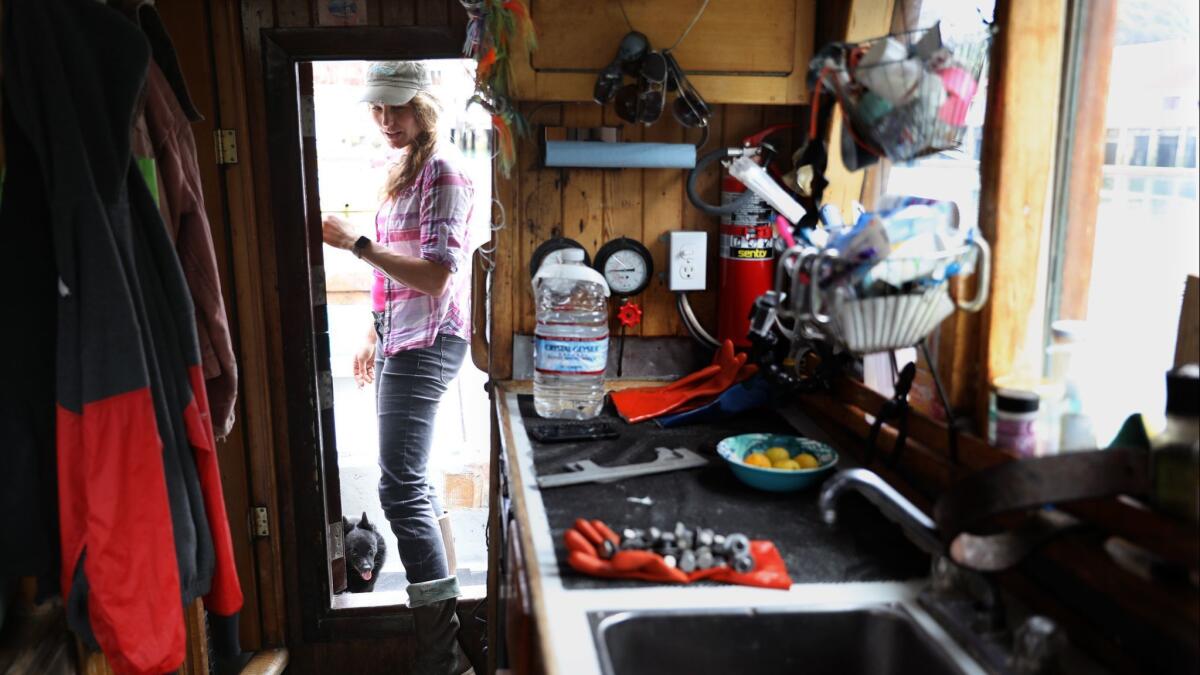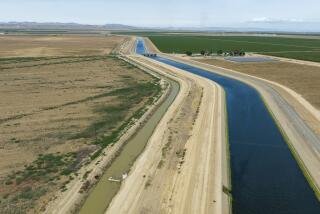Column: California’s salmon industry fears it will be wiped out by Trump

- Share via
Reporting from Fort Bragg, Calif — Heather Sears has been fishing for salmon out of this unassuming coastal community for nearly two decades. This year, for the first time since she arrived in 1999, she won’t be going out to sea.
“I just didn’t think we’d have much fish this year,” she was telling me in a chilly backroom of her newly opened fish market on the Noyo River, Fort Bragg’s marine thoroughfare. As she spoke, she expertly sliced into triangular fillets ideal for sashimi a 90-pound albacore that a tuna boat had caught off Hawaii and delivered to her fish market. But what was on her mind was the threat to the industry she had grown up in.
The state’s designated commercial salmon season, which normally runs from May 1 to Sept. 30, had been reduced to a wan shadow. This year it opened only on July 27, leaving scarcely enough time for California’s ocean-going boats to turn a profit. Some have ranged beyond the state’s waters, to Oregon, Washington or Alaska; others in the fishery shifted to crabbing. And others, like Sears, have tried to expand into other businesses, such as the fish market she launched on May 5 to backstop her fishing career.
As commercial fishermen, we’re not asking for all the water, but just as much as we need to keep our businesses viable and our communities strong.
— Heather Sears
There’s no question that the California salmon fishery is in a bad way. Stocks had barely recovered from the drought of 2007-2009, which destroyed the state’s inland spawning grounds and forced a total ban on commercial salmon fishing in 2008 and 2009, before a second drought struck. But a greater threat may be political, and man-made.
This column is one of a series on the conflicts between California and the Trump administration. Feel free to send comments or ideas to [email protected].

Heather Sears has seen her catch dwindle as water is diverted to agriculture from rivers where salmon spawn.
Agribusinesses in the Central Valley are demanding that more water be pumped out of the Sacramento-San Francisco Bay Delta to feed their farms. They’re getting a friendly hearing from the Trump administration and Republicans in Congress, who recognize that the valley is perhaps the only strongly Republican part of California. That water, allowed to follow its course through the state’s rivers and out to sea, is the lifeblood of the salmon fishery.
Salmon spawn and hatch in fresh waters inland, then migrate to sea within their first year. They spend their next few years offshore, where they become the commercial boats’ quarry, until the survivors migrate back upstream and start the cycle again. It’s the portion of their lifespans spent in fresh water, and therefore the health of the inland ecosystem, that determines the strength of the salmon fishery. In recent years, the ecosystem has come under stress from drought and diversions.
To Sears, 38, fishing is a lifestyle, not just a job choice. “All I know how to do is catch salmon,” she said.
Sears’ parents fished commercially out of Morro Bay, and first brought her along at the age of 8. She bought her first boat at 19, a 1928-vintage troller she acquired for $4,000. Her current vessel, the Princess, which she operates with an all-woman crew, is a 42-foot troller she acquired in Canada in 2008, when that country’s salmon industry underwent a shift from ocean fishing to salmon farming. (The boat was given its name by its previous owner.) It’s equipped with a blast freezer that can flash-freeze her wares to minus-40 degrees at sea, allowing her to stay out for a couple of weeks at a time and return with a larger catch. In a good year, she can earn $100,000, net of expenses.
“Salmon have lived through lots of droughts,” Sears said. “But they haven’t lived through droughts and the complete degradation of their ecosystem and the over-allocation of their water to Central Valley farmers. As commercial fishermen, we’re not asking for all the water, but just as much as we need to keep our businesses viable and our communities strong. We’re asking that we all take the same amount of cuts instead of us losing our entire seasons and them planting more almonds or whatever they do. I feel like we take the brunt.”
She’s right. Advocates of increased pumping for Central Valley farms typically talk as though the choice is between serving agriculture or allowing water to flow wastefully to sea to satisfy environmentalists. The interests of the commercial fishery are almost never mentioned. But it’s a big business too. A 2006 economic study valued the impact of the state’s salmon fishery at $1.4 billion in annual sales and 23,000 jobs. That was at a low ebb for the industry; if salmon could be restored to their full potential, the economists said, both figures would quintuple.
Instead, the fishery has deteriorated. Only 42,000 Chinook salmon — the California species marketed as king salmon — were landed at the state’s coastal ports in 2017, according to the Pacific Fishery Management Council. As recently as 2013, the figure was 298,000. The value of the catch has been falling, dipping to $4.9 million last year, 9% below the previous year and 43% below 2015.
President Trump made no secret during his campaign of his affinity for the growers. At an appearance in the Central Valley, he ignorantly parroted their viewpoint nearly verbatim. “You have a water problem that is so insane, it is so ridiculous, where they’re taking the water and shoving it out to sea,” he said. “They have farms up here, and they don’t get water. I said, ‘Oh, that’s too bad. Is it a drought?’ ‘No, we have plenty of water. … We shove it out to sea.’ … The environmentalists are trying to protect a certain kind of three-inch fish,” he said, referring to the delta smelt, which is typically treated as a species not worth preserving. (The smelt doesn’t occupy an especially important position in the delta food chain, but its health is an indicator of the overall health of the ecosystem.)
Once in office, Trump fulfilled the deepest desires of agribusiness by installing as the No. 2 official at the Department of the Interior David Bernhardt, a former lobbyist for the Westlands Water District, which depends on water from the Central Valley Project.
More than the health of the salmon industry is at stake in the conflict between the state and the Trump administration. Also affected are efforts by state officials to reconcile the water interests of farmers, urban dwellers, fishermen and others — a struggle over a scarce resource that has afflicted California politics for more than a century.
Water administrators and environmental experts say they have noticed a stark change in the federal government’s approach to water allocations since Trump’s inauguration. The spirit of collaboration that — with few and brief exceptions — kept the federal Bureau of Reclamation and its Fish and Wildlife Service on the same page as the state Water Resources Board and other state agencies has vanished. It’s been replaced by policies through which the administration aims to deliver more water to politically friendly growers in the strongly Republican Central Valley, especially at the expense of fish and the people who depend on them for their livelihoods.
That’s important because California’s State Water Project and the federal Central Valley Project both draw water from the northern part of the state and serve overlapping interests in Central, Southern and coastal California. Their mutual goal long has been to coordinate the projects to balance the needs of growers, urban users and fish and wildlife.
After the severe drought of 2007-2009, it became clear that even draconian cutbacks in water pumping to farms had done little to protect fish such as Chinook salmon, steelhead, smelt and sturgeon. In 2016, the Bureau of Reclamation, which manages federally funded dams and reservoirs, launched a round of consultations with state agencies over biological opinions that designated those species as endangered. The goal was to strengthen environmental protections for the fish.
“Those species were continuing to decline,” said Kate Poole, who has had a front-row seat at the discussions as a counsel for the Natural Resources Defense Council. Reclamation “recognized that the protections put in place in 2008 and 2009 weren’t working and if they weren’t improved those species were going to go extinct.”
Under Trump, however, “the Bureau of Reclamation has turned that on its head, saying they’re going to use it as an excuse to increase pumping and weaken protections for fish.”
Among other steps, the bureau has proposed changes in both the state and federal projects to “maximize water deliveries” to non-environmental users and consider “modifications to regulatory requirements” established by the biological opinions. Meanwhile, the Interior and Commerce departments have jointly proposed changes in the federal Endangered Species Act that would shrink the roster of species granted legal protections and loosen the rules protecting those that remain on the list.
California has been pushing back. The Legislature is considering a bill that would install pre-Trump environmental regulations as requirements of California law if the administration tries to roll them back. (One legislative aide calls the measure, SB 49, “Trump insurance.”) Last month, the state Water Resources Control Board proposed increasing the required water flows into the Sacramento-San Francisco Bay Delta and the San Joaquin River to protect what the board calls “an ecosystem in crisis.”
The administration responded with particular vehemence to the board’s initiative. In a July 27 letter to board Chair Felicia Marcus, the Interior Department threatened to sue the state over the proposed increases, arguing that the state was illegally trying to “co-opt” control of a federal project. That was a remarkable opening volley for a process requiring mutual consultation between two government authorities. “They’re certainly taking a far more confrontational approach than any previous administration of either party,” observed Richard M. Frank, an expert in environmental law at UC Davis.
The letter asserted that, contrary to the water board’s position, federal law prioritized irrigation over protections for fish. Experts say that’s flatly untrue, because the Central Valley Project Improvement Act of 1992 explicitly gave fish and wildlife protection equal standing. The state’s right to dictate the allocation of water even from a federal project, moreover, was validated by the Supreme Court in a landmark 1978 decision saying, in effect, that federal water projects have to comply with state regulations. “On water law, we have a ton of our own authority,” Marcus told me.
But the fishing industry can’t help but be fearful about how it will fare if the state and the Trump administration continue to wage war over water. “Structurally, we don’t have the protections we need,” said John McManus, head of the Golden Gate Salmon Assn. “Next time we go back into drought, it’s going to be as bad or worse than the last time.”
Keep up to date with Michael Hiltzik. Follow @hiltzikm on Twitter, see his Facebook page, or email [email protected].
Return to Michael Hiltzik’s blog.



